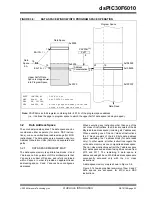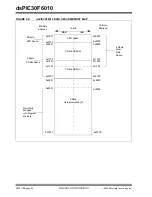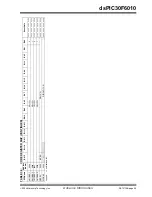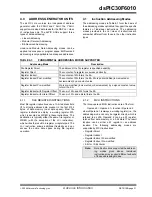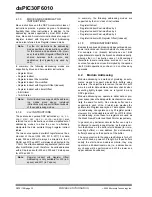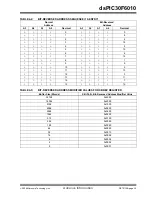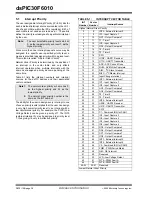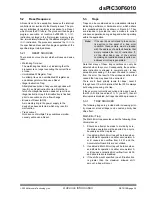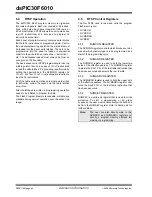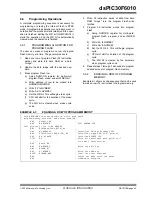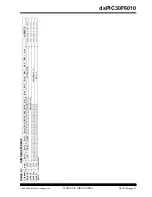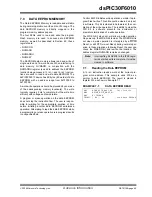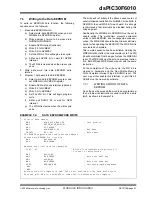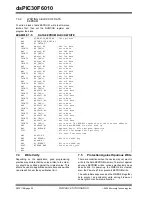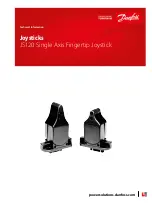
2004 Microchip Technology Inc.
Advance Information
DS70119B-page 37
dsPIC30F6010
5.0
INTERRUPTS
The dsPIC30F6010 has 44 interrupt sources and 4
processor exceptions (traps), which must be arbitrated
based on a priority scheme.
The CPU is responsible for reading the Interrupt Vec-
tor Table (IVT) and transferring the address contained
in the interrupt vector to the program counter. The
interrupt vector is transferred from the program data
bus into the program counter, via a 24-bit wide
multiplexer on the input of the program counter.
The Interrupt Vector Table (IVT) and Alternate Inter-
rupt Vector Table (AIVT) are placed near the beginning
of program memory (0x000004). The IVT and AIVT
are shown in Figure 5-1.
The interrupt controller is responsible for pre-
processing the interrupts and processor exceptions,
prior to their being presented to the processor core.
The peripheral interrupts and traps are enabled, priori-
tized and controlled using centralized special function
registers:
• IFS0<15:0>, IFS1<15:0>, IFS2<15:0>
All interrupt request flags are maintained in these
three registers. The flags are set by their respec-
tive peripherals or external signals, and they are
cleared via software.
• IEC0<15:0>, IEC1<15:0>, IEC2<15:0>
All Interrupt Enable Control bits are maintained in
these three registers. These control bits are used
to individually enable interrupts from the
peripherals or external signals.
• IPC0<15:0>... IPC11<7:0>
The user assignable priority level associated with
each of these 44 interrupts is held centrally in
these twelve registers.
• IPL<3:0> The current CPU priority level is explic-
itly stored in the IPL bits. IPL<3> is present in the
CORCON register, whereas IPL<2:0> are present
in the status register (SR) in the processor core.
• INTCON1<15:0>, INTCON2<15:0>
Global interrupt control functions are derived from
these two registers. INTCON1 contains the con-
trol and status flags for the processor exceptions.
The INTCON2 register controls the external inter-
rupt request signal behavior and the use of the
alternate vector table.
All interrupt sources can be user assigned to one of 7
priority levels, 1 through 7, via the IPCx registers.
Each interrupt source is associated with an interrupt
vector, as shown in Table 5-1. Levels 7 and 1 repre-
sent the highest and lowest maskable priorities,
respectively.
If the NSTDIS bit (INTCON1<15>) is set, nesting of
interrupts is prevented. Thus, if an interrupt is currently
being serviced, processing of a new interrupt is pre-
vented, even if the new interrupt is of higher priority
than the one currently being serviced.
Certain interrupts have specialized control bits for fea-
tures like edge or level triggered interrupts, interrupt-
on-change, etc. Control of these features remains
within the peripheral module which generates the
interrupt.
The
DISI
instruction can be used to disable the
processing of interrupts of priorities 6 and lower for a
certain number of instructions, during which the DISI bit
(INTCON2<14>) remains set.
When an interrupt is serviced, the PC is loaded with the
address stored in the vector location in Program Mem-
ory that corresponds to the interrupt. There are 63 dif-
ferent vectors within the IVT (refer to Figure 5-2). These
vectors are contained in locations 0x000004 through
0x0000FE of program memory (refer to Figure 5-2).
These locations contain 24-bit addresses, and in order
to preserve robustness, an address error trap will take
place should the PC attempt to fetch any of these
words during normal execution. This prevents execu-
tion of random data as a result of accidentally decre-
menting a PC into vector space, accidentally mapping
a data space address into vector space, or the PC roll-
ing over to 0x000000 after reaching the end of imple-
mented program memory space. Execution of a
GOTO
instruction to this vector space will also generate an
address error trap.
Note:
Interrupt Flag bits get set when an inter-
rupt condition occurs, regardless of the
state of its corresponding Enable bit. User
software should ensure the appropriate
Interrupt Flag bits are clear prior to
enabling an interrupt.
Note:
Assigning a priority level of 0 to an inter-
rupt source is equivalent to disabling that
interrupt.
Note:
The IPL bits become read-only whenever
the NSTDIS bit has been set to ‘
1
’.
Summary of Contents for dsPIC30F6010
Page 12: ...dsPIC30F6010 DS70119B page 10 Advance Information 2004 Microchip Technology Inc NOTES...
Page 32: ...dsPIC30F6010 DS70119B page 30 Advance Information 2004 Microchip Technology Inc NOTES...
Page 38: ...dsPIC30F6010 DS70119B page 36 Advance Information 2004 Microchip Technology Inc NOTES...
Page 50: ...dsPIC30F6010 DS70119B page 48 Advance Information 2004 Microchip Technology Inc NOTES...
Page 68: ...dsPIC30F6010 DS70119B page 66 Advance Information 2004 Microchip Technology Inc NOTES...
Page 72: ...dsPIC30F6010 DS70119B page 70 Advance Information 2004 Microchip Technology Inc NOTES...
Page 76: ...dsPIC30F6010 DS70119B page 74 Advance Information 2004 Microchip Technology Inc NOTES...
Page 86: ...dsPIC30F6010 DS70119B page 84 Advance Information 2004 Microchip Technology Inc NOTES...
Page 108: ...dsPIC30F6010 DS70119B page 106 Advance Information 2004 Microchip Technology Inc NOTES...
Page 116: ...dsPIC30F6010 DS70119B page 114 Advance Information 2004 Microchip Technology Inc NOTES...
Page 128: ...dsPIC30F6010 DS70119B page 126 Advance Information 2004 Microchip Technology Inc NOTES...
Page 150: ...dsPIC30F6010 DS70119B page 148 Advance Information 2004 Microchip Technology Inc NOTES...
Page 164: ...dsPIC30F6010 DS70119B page 162 Advance Information 2004 Microchip Technology Inc NOTES...
Page 208: ...dsPIC30F6010 DS70119B page 206 Advance Information 2004 Microchip Technology Inc NOTES...
Page 220: ...dsPIC30F6010 DS70119B page 220 Advance Information 2004 Microchip Technology Inc NOTES...
Page 221: ...2004 Microchip Technology Inc Advance Information DS70119B page 221 dsPIC30F6010 NOTES...

